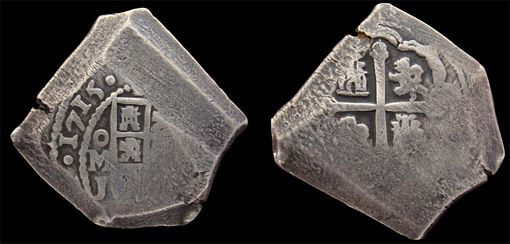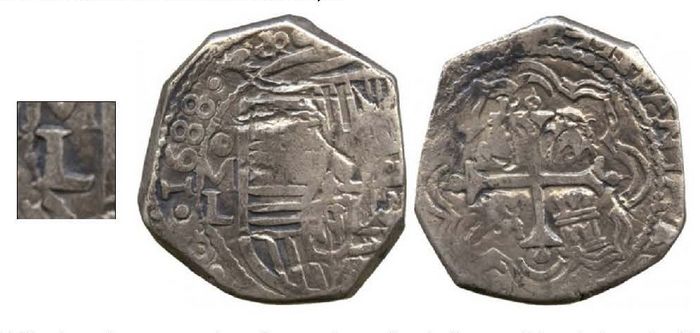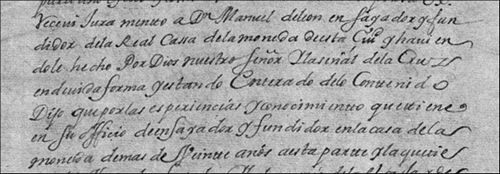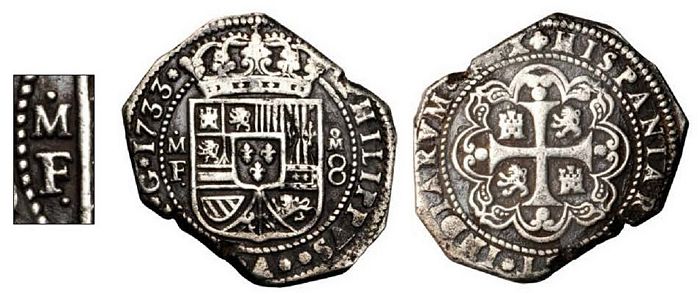Who were Mexico City Mint Assayers L and J (1677-1723)?
by Jorge A. Proctor
Finding ourselves celebrating the 300th anniversary of the sinking of the 1715 treasure fleet off the coast of Florida, it only seems appropriate to write about the Mexican assayers whose initials are found on almost all Mexican coins recovered from this fleet. Initials L and J, according to most numismatic reference works dating back to at least 1975, identify assayers Martín López (L) and José Eustaquio de León (J) J. Pellicer i Bru, Glosario de Maestros de Ceca y Ensayadores. 1st Edition, Barcelona, Spain, 1975, pp. 132 and 143. This 1975 book by Josep Pellicer i Bru is the earliest reference that could be found where these assayers are named as Martín López (assayer L) and José Eustaquio de León (assayer J).
A. Herrera. El Duro (Madrid, Spain, 1914), Vol. 1, p. 213; A. F. Pradeau, Numismatic History of Mexico from the Pre-Columbian epoch to 1823 (New York, NY, 1978). Updated reprint of original published in 1938, with annotations and revisions by Clyde Hubbard, Cuernavaca, Mexico, 1978, p. 33; T. Dasí, Estudio de los Reales de a Ocho (Valencia, Spain, 1950), Vol. III, p. XLIX, No. 1,120. It should be noted that although Adolfo Herrera (1914), Alberto Pradeau (1938) and Tomás Dasí (1950) never knew the name of assayer L, they all documented the identity of assayer J simply as José (or Joseph) de León.
Casa de Moneda de México: Presencia en el Mundo 1535-1990. Published by Miguel Angel Porrúa, Mexico (1990), pp. 79 and 82. Assayer L is correctly identified as Manuel de León, but without any reference to the source for this statement. Oddly enough, this book also offers no identification for assayer J. The lack of a single source or reference on this book to corroborate the statement that assayer L was Manuel de León seem to have been what has kept this name so hidden, as it could not be verified until now.. But are these the correct identifications for assayers L and J? The research I present below says the answer is NO. So, if Martín López was not assayer L and José Eustaquio de León was not assayer J, who were assayers L and J? Fortunately, the true identities of assayers L and J were also uncovered in my research.

Typical assayer J Mexican 8 reales recovered from the 1715 Fleet.
(Image courtesy of The 1715 Fleet Society)
The key to the true identities of assayers L and J, I must confess, emerged somewhat serendipitously in the course of other research I was conducting. Several contemporary documents record the proceedings of a trial conducted in 1718 between the current assayer at the mint (assayer J) and the Carmelite Convent of the Holy Desert. The Carmelite order was, to my surprise, represented as the long-time owner of the office of assayer and smelter at the Mexico City mintJ. de Ordaz, Por los Reverendos Padres Prior y Carmelitas Descalços, Hermitaños de el Santo Decierte de este Reyno, como Dueños de los Officios de Ensayador, y Fundidor Mayor de la Real Casa de Moneda de esta Corte en los autos con Don Joseph de Leon su Theniente, que ha sido en dicho Officios. Con Licencia del Supremo Gobierno en México en Imprenta nueva Plantiniana de Juan Francisco de Ortega y Bonilla, 1721, fol. 1r.. Assayer J had been appointed (in 1705) by the Carmelites as the working assayer. As part of this trial, the Carmelites presented a copy of the contract that had been given to assayer J’s predecessor, assayer L. Assayer L was named. The name was not Martín López, but Manuel de León.
Somewhat startled by what I had just read, I immediately called a friend of mine with ample knowledge of the history of the Mexican mint and asked him, “what do we actually know about Martín López and where is the confirmation that he was assayer L?” A moment of silence followed, ending in a single question: “where are you going with this, Jorge?” That was good enough for me! I knew that I was on the right track and that I just had been given the green light to proceed.
I realized at once that the true story of assayer L now had two parts. If assayer L was in fact Manuel de León, then I should be able to find the confirmatory evidence of this in at least one document from the period that assayer L was in office. But Martín López also had to be dealt with. Who was he? Did any evidence support his association with the Mexico City mint, if not as assayer L, then in some other capacity? How had Martín López become identified as assayer L? My research uncovered the salient facts of Martín López’s career in Mexico, but not a good explanation of why he was later identified as assayer L.
Martín López was an assayer in Mexico. In 1656 he was appointed as Assayer and Weight Master of the Foundry of the city of Mexico (Ensayador y Balanzario de la Real Caja de México). On 22 November 1662 he signed a contract with the Mexican Viceroy Juan de Leyva de la Cerda, Conde de Baños y Marqués de Leyva y de Ladrada. López agreed to manage the extraction of the quicksilver deposits in the Chilapa area, located about 130 miles directly south of Mexico, under license from the Crown, but at his own expense. With little experience and a lack of knowledge in the field of quicksilver extraction, the project soon proved a disaster. It ended up costing him both this commission and also his job at the Mexican foundry in 1669. Dismissed from the foundry, López virtually disappears by the summer of 1669, although he is still writing correspondence in July of 1670Archivo General de Indias (AGI): Patronato, 238, N. 2, R. 14. and still attempting to regain his lost commission and foundry offices. In December of 1670 he is reported as unlawfully collecting tributes from the Indians. We last hear about Martín López in January of 1671, when measures were taken to ensure that he would no longer receive any benefits he was not entitled to. With this notice his name vanishes from the recordsM. F. Lang, Martin Lopez and the Chilapa Quicksilver Mines 1658-1670. Pan American Institute of Geography and History, Revista de Historia de América, No. 69, Jan. - Jun., 1970, pp. 41-61..

Martín López’s signature, as found on a letter dated in Mexico on 15 July 1670. This letter was Martín López’s last attempt to regain
the commission and foundry offices he had lost. (Source: AGI: Patronato, 238, N. 2, R. 14)
Meanwhile, as Martín López vanishes from the historic record, the working assayer at the Mexico City mint is Gerónimo Becerra (assayer G). Gerónimo had been working as deputy to his brother Pedro Becerra (assayer P)Archivo General de la Nación (AGN): Instituciones Coloniales, Gobierno Virreinal, Reales Cédulas Originales y Duplicados (100), Reales Cédulas Duplicadas, Vol. D48, Exp. 285, f. 191r-193r. since 9 April 1644. He was promoted to working assayer at the mint by Sebastian Carrillo Maldonado on behalf of the Carmelites in 1665, following the death of his brotherM. L. Rodríguez-Sala, Tres Constructores de Obras Científico-Técnicas de Minería y Metalurgia en la Nueva España del Siglo XVII: Luis Berrio de Montalvo, Jerónimo de Becerra y Juan del Corro. Instituto de Investigaciones Sociales, Universidad Nacional Autónoma de México (UNAM), Anuario de Estudios Americanos, Vol. 57, No. 2, 2000, p. 656.. Gerónimo Becerra continues working the post until around 21 January 1677AGN: Instituciones Coloniales, Gobierno Virreinal, Reales Cédulas Originales y Duplicados (100), Reales Cédulas Duplicadas, Vol. D31, Exp. 176, f. 142vta. when, due to an ailment, Manuel de León, an assayer about 32 years of ageAGI: México, 202, N. 19. While providing a deposition in December of 1697, Manuel de León’s age is recorded as around 52 years old. This would make him around 32 years old by the time that he became the assayer on record at the mint in 1677., is appointed to serve as interim assayer while Gerónimo recuperates. By 12 February 1677AGN: Instituciones Coloniales, Gobierno Virreinal, Reales Cédulas Originales y Duplicados (100), Reales Cédulas Duplicadas, Vol. D31, Exp. 177, f. 142vta.) it seems that Geronimo’s condition had taken a turn for the worst, and Manuel de León is now promoted to the rank of lieutenant assayer at the mint. Three days later, on 15 February 1677, Gerónimo diesRodríguez-Sala (op. cit., n. 6.). Manuel de León is confirmed as Gerónimo’s replacement, again, on the following dayAGN: Instituciones Coloniales, Gobierno Virreinal, Reales Cédulas Originales y Duplicados (100), Reales Cédulas Duplicadas, Vol. D31, Exp. 178, f. 143. .
Currently nothing is known about Manuel’s life or career before he is appointed the new working assayer and smelter at the Mexican Mint. Although contemporary references to Manuel’s quiet tenure are somewhat scarce, at least several documents do exist during the period that he served as the mint’s assayer.

1688 Mexican 8 Reales with assayer mark L for Manuel de León.
Images from the Baldwin's Auctions #71, 29 September 2011, Lot #1790. (Courtesy of A. H. Baldwin & Sons Ltd, London)
The first reference dates to 21 July 1691, when the construction of a new throne for the image of the virgin at the Church of Our Lady of the Remedies (Nuestra Señora de los Remedios) was being proposedG. Ramos de Castro, Nuestra Señora de los Remedios de México: aportaciones al estudio de su orfebrería. Boletín del Seminario de Estudios de Arte y Arqueología: BSAA, Tomo 62, 1996, pp. 478-481. Manuel de León, described as the assayer of the mint, is credited with drafting the blueprints for this new throne. According to this document, the design from his registered blueprints had already been approved in 1690.
The second reference, which is the more informative, dates to December 1697, when Manuel was summoned by the City Council as part of a hearing for the selection of a new assayer at the foundry. Manuel is asked to provide testimony as to the competency of the nomineeAGI (op. cit., n. 8.). According to minutes of the hearing, Manuel de Léon is brought in to testify on 11 December. Asked to state his qualifications as an expert witness, Manuel says he is qualified to provide such testimony “due to the experience and knowledge that he has had in his job as assayer and smelter at the mint for more than twenty years to these parts.” This statement is a clear confirmation of the year in which he started his tenure as assayer L. As we saw above, Manuel was appointed to succeed Gerónimo Becerra in 1677.
Manuel de León continued as the mint’s assayer until 1705. On 23 February of that year his brother, José de León, is brought in as an interim assayer, when Manuel is unable to continue due to an incapacitating illnessAGN: Instituciones Coloniales, Real Hacienda, Casa de Moneda (021), Vol. 6, Exp. 87, f. 253-256. This José de León should not to be confused with José Eustaquio de León, about whom we will have more to say presently. José de León had already been working as Manuel’s deputy at the time of his selectionAGI (op. cit., n. 8). José de León is recorded as already serving as deputy of his brother Manuel de León by December of 1697., making for a smooth transition in February. Not many days later, Manuel de León dies. José is promoted to the rank of lieutenant assayer at the mint by the Carmelites on 11 March 1705de Ordaz (op. cit., n. 2.), and he is ratified on 9 April 1705AGN: Instituciones Coloniales, Real Hacienda, Casa de Moneda (021), Vol. 6, Exp. 89, f. 261v-264v.. José was about 52 years old when he became the working assayer in 1705AGI (op. cit., n. 8). While providing a deposition in December of 1697, José de León says he is about 44 years old. This would make him approximately 52 years old by the time that he became the assayer on record at the mint in 1705.. At 52 José was already what would be considered an older man in this period. In 1715 he attempted to appoint his own son, Manuel de León, as his deputy. As his official deputy or lieutenant (teniente), Manuel could have continued to work the post if José were sick or absentPor el Alferez Don Joseph de Leon Ensayador, y Fvndidor Mayor de la Real Cassa de Moneda de este Reyno, en el Pleyto con el P. Prior, y Comunidad de el Santo Desierto de Carmelitas Descalços, Con Licencia: en México, Por los Herederos de la Viuda de Miguel de Ribera, 1721, fol. 2v, 5th numbered paragraph.. The appointment was rejected by the Carmelites due to Manuel’s age at the time. Manuel was said to be under 25 years of age. A working assayer or his deputy had to be 25 years old to hold these posts at the Mexico mintPor el Alferez Don Joseph de Leon… (ibid, n. 19.).)


Image of the portion of the very important document from 11 December 1697, identifying Manuel de León as the assayer at this mint by this date,
and including that he had been working this post for the past 20 years.(Source: AGI: México, 202, N. 19)
By 1718 José de León had suffered an accident, when he fell off a ladder at the mint, and ended up as a convalescentPor el Alferez Don Joseph de Leon… (ibid, n. 19.), fol. 1v, 1st numbered paragraph.. This time, rather than just appoint Manuel as a deputy, José decided that it would be best to transfer the office to his son, whom he saw as a good and capable candidate. José went before the head of the Carmelite convent, Prior Fray Martín de la Madre de DiosEl Santo Desierto de los Carmelitas de la Provincia de San Alberto de México. Revisión Paleográfica Introducciones y Notas por Dionisio Victoria Moreno y Manuel Arredondo Herrera. Biblioteca Enciclopédica del Estado de México, México, 1978, p. 580. Martín de la Madre de Dios became the Prior of the Carmelite Convent of the Holy Desert in 1713 and remained in office until 1720., to make his wishes known. The Prior immediately set a date for him or his son to return and present José’s formal letter of resignation and the birth certificate of his son Manuel, proof that he was now of the required age. When that day came and went with no sign of José or his son, Fray Martín de la Madre Dios wasted no time in appointing a new assayer. Don Juan de Cueva, a former assayer from the mines of San Luis de Potosí, was appointed to replace José at the mint. But José de León was not about to go quietly! Before Juan de Cueva could be ratified by Spanish authorities, José quickly filed a lawsuit claiming that there had been a misunderstanding. This action successfully blocked the appointment of Juan de Cueva by the CarmelitesPor el Alferez Don Joseph de Leon… (op. cit., n. 19.). Ultimately, José de León won his lawsuit and remained in office until at least 1723, which is the last date attested by the coinage.
This brings us to José Eustaquio de León, a son of José de León, the mint assayer (1705-1723), and a brother of Manuel de León, the same Manuel to whom his father had attempted to give the office of assayer in 1718. Although José Eustaquio de León was trained in the family trade, which made him a skilled assayer in his own right, he chose instead to follow a different path, becoming a priestde la Encina y la Carrera, Juan Ignacio. En la Causa que Pende en Dicha Real Junta contra el Thesorero, Ensayador, y otros Oficiales de la Casa de Moneda de Mexico. Sobre Falta en la Obligación de sus Oficios. Circa. 1735. By 1729 we already have José Eustaquio de León, the son of the former assayer at the mint, José de León, described as a presbyter (a priest).
Archivo General de Centro América (AGCA), A1.4, Protomedicato, Leg. 4026, Exp. 30997. Pamphlet titled: Uirtudes de la Essencia Tinturada de el Bálsamo Virgen (printed in 1756 in Guatemala at the printing press of Joaquín de Arévalo, printer for the Ecclesiastical Tribunals). Written by José Eustaquio de León himself, this pamphlet informs us that besides being Director of the Guatemala Mint he became a domiciliary of the Archbishopric of Mexico (Domiciliario de el Arzobispado de México).. This prevented him from ever taking a post as a paid assayer. When he was called upon with his brother Manuel to assist during a 1729 mint investigation, José Eustaquio’s skills as an assayer became more than apparentde la Encina y la Carrera, Juan Ignacio (op. cit., n. 24). Later on both brothers established successful mint careers, though in different ways. Manuel de León, rejected by the Carmelites as deputy assayer and successor to his father José, had become a Contador (accountant) G. Céspedes del Castillo, Las Casas de Moneda de los Reinos de Indias, Vol. 1, Las Cecas Indianas en 1536-1825 (Madrid, 1996), p. 90; M. P. Pérez García, Regulación Contable en las Ordenanzas de las Casas de Moneda y Praxis Habitual. Revista Española de Financiación y Contabilidad, Vol. XXVIII, n. 56, 1988, pp. 351-372. The position of Contador (accountant) was first added to the list of mint positions by the Spanish code of laws regulating mining operations known as the Ordenanzas of 26 January 1718. Included again in the Ordenanzas of 9 June 1728, this position quickly gained importance. The Ordenanzas of 16 July 1730 includes this position among the three highest at the mint, being placed below that of Superintendent and yet above that of Treasurer. at the mint of Mexico City by 1730Herrera, El Duro, Vol. 1, Madrid, Spain, 1914, p. 213.. Ratified for this position on 2 August 1731 Herrera (ibid, n. 27.), he was later moved to the post of assayer by Royal decree signed in Seville, Spain on 14 July 1732Herrera (ibid, n. 27.). Manuel (assayer M) worked as assayer with Francisco de la Peña y Flores (Assayer F) from 1733 until 1754 and with Manuel de Asorin (assayer M) from 1754 until 1769AGN: Instituciones Coloniales, Gobierno Virreinal, Reales Cédulas Originales y Duplicados (100), Reales Cédulas Originales, Vol. 234, Exp. 78, f. 2. This document, from 18 October 1755, confirms the approval of Manuel de Asorin as the new working assayer of the mint due to the death of Francisco de la Peña y Flores. Manuel de Asorin had already started working in place on Francisco de la Peña y Flores sometime in 1754, as the coins confirm.. He died in 1769, at which time he was replaced by Manuel de la Iglesia (assayer M) AGN: Instituciones Coloniales, Real Hacienda, Casa de Moneda (021), Vol. 45, Exp. 24, f. 80. On 1 December 1769 Manuel de la Iglesia is assigned as a working assayer of the mint in place of Manuel de León who has just died. No numismatic text known to me correctly identifies the name of the new assayer M who followed Manuel de León in December of 1769 as Manuel de la Iglesia.
J. Pellicer i Bru (op. cit., n. 1), p. 154. Josep Pellicer i Bru claims that Francisco Pradeau documented an assayer who worked concurrently with Francisco de la Peña by the name of Manuel de la Rivera. This has caused some to believe that the assayer who followed Manuel de León was in fact this Manuel de la Rivera. Searching through Pradeau’s Numismatic History of Mexico from the Pre-Columbian epoch to 1823, I have not been able to uncover any statements regarding an assayer named Manuel de la Rivera, and other documents from the archives make it clear that the new assayer was Manuel de la Iglesia, not Manuel de la Rivera.. José Eustaquio de León, although he could not work the post of assayer due to his priestly vows, did not have a restriction on performing a more administrative job. He agreed to become the new Director of the Mint of Guatemala at the time of its establishmentC. Jara M. Historia de la Casa de Moneda de Guatemala 1731-1776. Impreso por Andros Impresores, Santiago, Chile, 2010, pp. 12-13.. Appointed in 1732Jara M. (ibid, n. 32), pp. 16-17. he traveled from Mexico to Guatemala, where he oversaw the founding of the mint in 1733. José Eustaquio continued to manage it until 1767, when the post of Director was suppressed and he was finally retiredJara M. (ibid, n. 32), pp. 147-148.. The last we hear of José Eustaquio is in 1768, when he was reported as still receiving a pension Jara M. (ibid, n. 32), p. 149..

1733 Mexican klippe (recortada) 8 reales with the marks of assayers Manuel de León (M) and Francisco de la Peña (F)
(Daniel Frank Sedwick Treasure Auction #4, Lot #548, 6 November 2008, lot #548)
On a final note, I would like to make mention that outside of the scope of this article we do have another member of the de León family that should be mentioned. This is José de León y Sosa, who worked the post of assayer in Guatemala from 1733-1759Jara M. (ibid, n. 32), pp. 15. Again, as we see from the previous explanations, the fact that the director and assayer of the Guatemala mint had such similar names, and both were skilled assayers and worked at the same time, has caused confusion. Some writers have mistakenly thought that the director and the assayer where one and the same person. In fact, the Guatemalan assayer in this case is actually a nephew of the mint director, José Eustaquio de León Jara M. (ibid, n. 35).
| Initial | Name | Began on | Left office on |
| L | Manuel de León | ||
| J | José de León |
